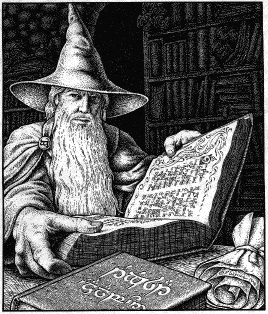Tolkien's world
 J.R.R.
Tolkien was a philologist specializing in the history of the English language,
and Professor of Anglo-Saxon at Oxford University. By the time he was twelve
years old, in 1904, he was making up languages for fun. Later in life, he began
to invent a world for those languages to fit into, and adventure stories about
things that happened in that world.
J.R.R.
Tolkien was a philologist specializing in the history of the English language,
and Professor of Anglo-Saxon at Oxford University. By the time he was twelve
years old, in 1904, he was making up languages for fun. Later in life, he began
to invent a world for those languages to fit into, and adventure stories about
things that happened in that world.
Three
books were crucial in developing Tolkien's linguistic imagination: Joseph
Wright's Primer of the Gothic Language; C.N.E Eliot's Finnish Grammar;
and John Morris-Jones' Welsh Grammar.
From his Gothic primer, Tolkien learned about reconstructing Indo-European
linguistic history through the comparative method, as it had been developed
by 19th-century scholars. His encounter with Finnish opened his mind to the
exotic structures of a non-Indo-European language, which he described as "like
discovering a complete wine-cellar filled with bottles of an amazing wine of
a kind and flavour never tasted before." As a boy, he had seen in Welsh
place-names "a flash of strange spelling and a hint of a language old and
yet alive", and when he won an English prize as an undergraduate at Oxford,
he spent his prize money on a Welsh grammar.
Throughout his life, he imagined new languages and along with them, new systems
of writing, new linguistic histories, new literatures, and a new world. All
of these were inspired by his study of real-world languages, histories and literatures,
where he had the credentials of a serious scholar.
In Tolkien's fantasy world, different languages generally belong to different
races -- elves, dwarves, men, hobbits, orcs and others -- who are very different
from one another in every other way as well. They look different, they live
in different habitats, they do different kinds of work, they are interested
in different things, they have different life-spans (elves in particular are
immortal), they have different preferred weapons, they live in different kinds
of houses and wear different sorts of clothes, they have different sex lives
(dwarvish females have beards, are less than 1/3 as numerous as males, and never
appear in public), and so on.
Thus Tolkien's races are radically different from one another in biology, language
and culture; and across these races, biology, language and culture are well
correlated. This was the predominant 19th-century view.
This is not Middle Earth
However, even 19th-century scholars in fact knew that biology and language
correlate badly if at all. For example, the great American linguist William
Dwight Whitney wrote in 1864 that
One of the first considerations which will be apt to
strike the notice of any one who reviews our classification of human races
according to the relationship of their languages, is its non-agreement with
the current divisions based on physical characteristics.
Furthermore, scientific examination of human physical, linguistic and cultural
variation generally does not produce well-defined and well-separated bundles
of characteristics corresponding to the categories of "race" and "language",
but rather complex geographical and social patterns of graded variation in statistical
frequencies of traits.
So human reality does not divide us cleanly into dwarves, elves, men, hobbits
and orcs, not biologically and not even linguistically. Furthermore, if we insist
on the common folk categories of race and language, or do our best to make up
new ones with better scientific grounding, we find that biological, linguistic
and cultural traits often do not line up.
Nevertheless, people find it very hard to avoid thinking like Tolkien did.
It's easy and natural to imagine that intelligent beings divide into well-defined
biological subgroups, and that members of these groups tend to have different
personalities, different strengths and weaknesses, different cuisines, different
ways of talking, and so on. Tolkien's Middle-Earth is not the only imaginary
world based on this idea: think about Star Trek, and Star Wars, or even the
world of Pokemon.
Francisco Gil-White (of Penn's Psychology Department) has argued,
based on his cross-cultural research, that
humans process ethnic groups (and a few other related
social categories) as if they were “species” because their surface
similarities to species make them inputs to the “living kinds” mental
module that initially evolved to process species level categories.
This is not Tolkien's Middle Earth. But most people still think it is, at least
sometimes. 19th-century anthropology resurfaced many times as 20th-century fantasy,
and the 21st century is continuing the tradition. If Prof. Gil-White is right,
this is because 19th-century anthropology simply recapitulates the folk-ontology
of ethnicity.
In this course, we'll explore some other ways of thinking about the phenomena
of human variation in biology, language and culture.
 J.R.R.
Tolkien was a philologist specializing in the history of the English language,
and Professor of Anglo-Saxon at Oxford University. By the time he was twelve
years old, in 1904, he was making up languages for fun. Later in life, he began
to invent a world for those languages to fit into, and adventure stories about
things that happened in that world.
J.R.R.
Tolkien was a philologist specializing in the history of the English language,
and Professor of Anglo-Saxon at Oxford University. By the time he was twelve
years old, in 1904, he was making up languages for fun. Later in life, he began
to invent a world for those languages to fit into, and adventure stories about
things that happened in that world.